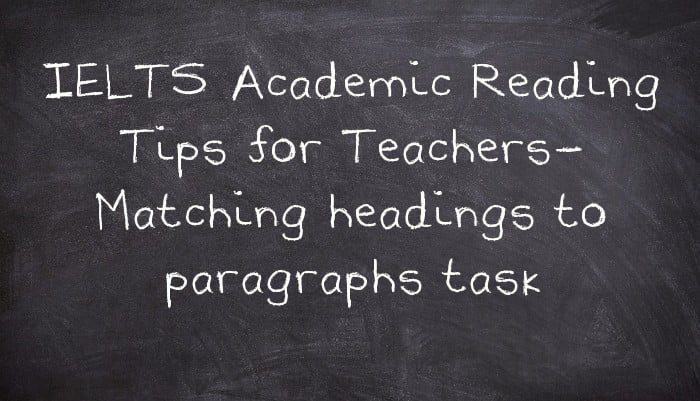Description of the task:
In this task type, which often appears in the exam, students are given a text with 5 to 7 paragraph headings missing. They must select the right paragraph headings from a list. There are always more paragraph headings than paragraphs (so that students can't fill in the last one by a process of elimination).
Teaching tips:
This task type is the best one to start with when practising and teaching IELTS reading for the first time, as doing the task doesn't usually rely on knowing specific vocabulary and there may be several cues in each paragraph that match each paragraph heading. It can, however, still be a shock for students seeing a real IELTS reading for the first time, so it is best to simplify the task the first few times they see it. The ideas below can also be used later in the course to give students hints before you go through the answers.
An easy start
- Give the students the texts and paragraph headings cut up so they can physically match them up
- Give the paragraph headings in order and the text mixed up or cut up and get them to match them
- Give a real exam task, but without the extra distracting paragraph headings
- Instead of mixed up paragraph headings, give the students two or more options for each paragraph heading, using the distractors and some of the other paragraph headings as the extra choices
- Give the students the exam task with the parts of the text that have the important information in already underlined
- Get the students to do one of the fun tasks below, e.g. where they write their own paragraph headings, before you give them the real exam task, so that they already know the text well
Fun practice
- Give the students an exam task with the paragraph headings mixed up but no extra distractor headings. Get students to write out the distractor paragraph headings for a task they will then give another team to try and answer (they will need to copy out the real paragraph headings by hand as well so the other group can't easily see which headings they have written).
- Give them a task with no headings and get them to write all the mixed up headings for another team to try to match up.
- Do the task as a running dictation. One student has just the mixed up paragraph headings. The other student runs back and forward to the texts, which are stuck on a wall, and describes what is written to their seated partner. The person seated can only say "Okay" when they think they have enough information about one paragraph to match it to one of the paragraph headings they have been given or "More" if they want their partner to run back and get them more details. The first team to finish the task correctly is the winner.
- Cut up one exam text between the paragraphs and put all the paragraphs up on various places on the walls around the room with envelopes below each one. Photocopy and cut up the paragraph headings (without the distactors) so there are at least 4 headings per student. Mix them up and give out one cut up paragraph heading to each student. They should stand up, walk around and find the correct paragraph for the heading they have been given, write their name on the back of the paragraph heading paper, put it in the right envelope and go to the teacher to ask for another one. When the time limit is up or all the paragraph heading slips of paper have been used up, the student with the most paragraph headings in the right envelopes is the winner.
- Give one paragraph heading to each group and ask them to write the text for that paragraph heading. Shuffle up the finished texts and the paragraph headings, give each team someone else's text and someone else's paragraph heading (that doesn't match that text) and then the whole class tries to match them up. This can be done either by showing them to each other or describing them to each other (a bit like a Find Someone Who mingling activity). Obviously people cannot help match the texts and paragraphs that they wrote.
The next step
- The task which is most similar to this but a step up is the "Locating Information" task, where the sentences given match some information somewhere in a particular paragraph (rather than summarizing the whole paragraph like this task).
